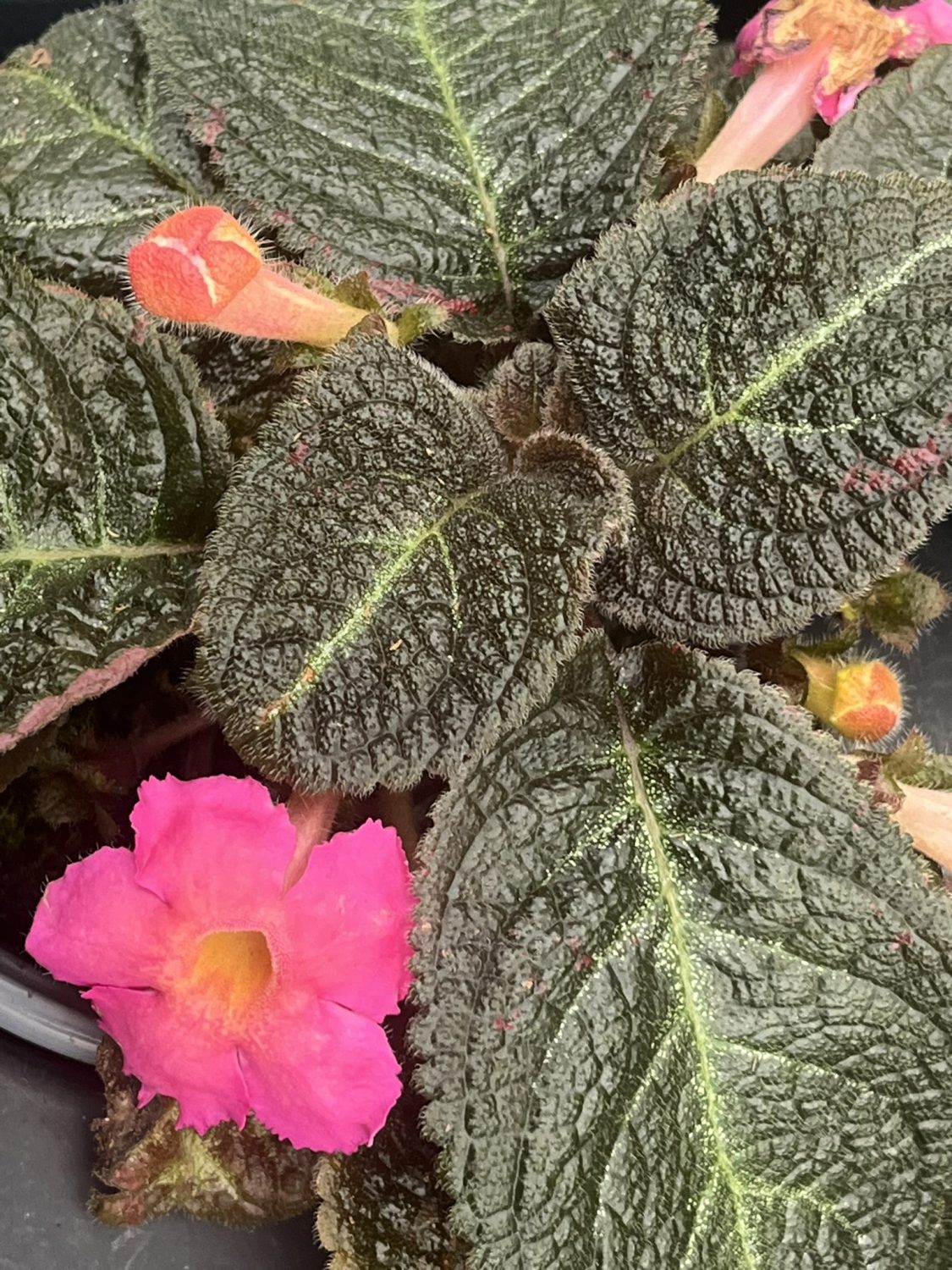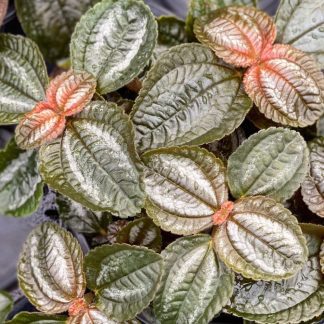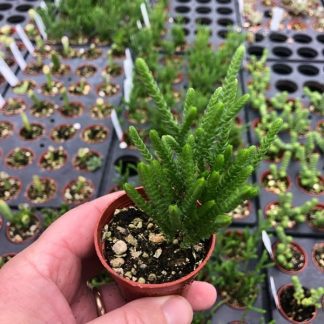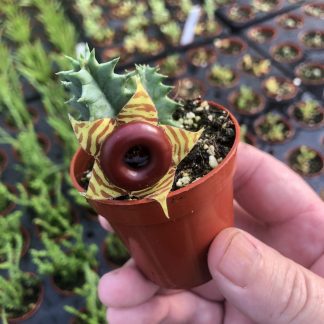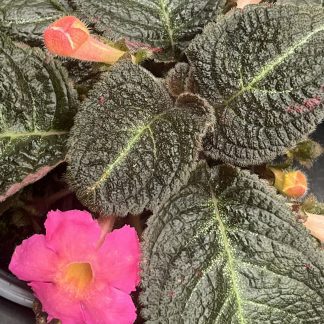Description
Episcia cupreata ‘Pink Panther’ — Flame Violet with Playful Pink
Meet the Plant We All Fall For
We love plants that feel special the moment you see them. Episcia cupreata ‘Pink Panther’ is one of those plants. The foliage glows with soft pink tones, silver highlights, and deep green veins. The leaves are velvety. The habit is low and gently trailing. And the flowers? Small, tubular, and bright—like tiny fireworks that keep popping through the season. In other words, this is a plant that looks fancy but lives easy. We get color, texture, and charm in one compact package.
Why ‘Pink Panther’ Stands Out
- Velvet leaves with pink shimmer. The variegation brings silver and blush pink to each leaf. It looks painted by hand.
- A compact trailer. Stems creep and spill, but the plant stays neat. Perfect for shelves, windows, and small hangers.
- Bright blossoms. The blooms are cheerful and frequent in warm months. They rise above the leaves and say, “Look at me!”
- Easy to grow indoors. This is a tropical understory plant. So it thrives in bright, indirect light and normal room temps.
- Terrarium-friendly. It loves steady moisture and humidity. That makes it a star in enclosed or semi-enclosed displays.
Instead of a fussy diva, we get a warm companion plant that works with us. But most of all, ‘Pink Panther’ rewards simple, steady care with constant color.
Fast Facts (So You Can Place It Right)
- Botanical name: Episcia cupreata ‘Pink Panther’
- Common name: Flame Violet ‘Pink Panther’
- Light: Bright, indirect light; no harsh midday sun
- Water: Keep evenly moist, never soggy; let the top ½ inch dry
- Humidity: Medium to high; 50–70% is ideal
- Temperature: 65–80°F; avoid cold drafts
- Growth habit: Low, spreading, and trailing via runners (stolons)
- Best spots: East or north windows, bright rooms, plant shelves, terrariums
- Container: Shallow pots or small hanging baskets with airy soil
The Look: Soft Velvet, Sweet Pink, Always Lush
‘Pink Panther’ is all about feel and glow. The leaves are thick and soft, like a velvet ribbon. The pink mix is playful, not loud. Silver flecks catch the light. Deep green veins add contrast. When the plant spills over the edge of a pot, it creates a gentle waterfall of color. After more than a few weeks of simple care, you’ll notice the runners reach out and root. That’s how it forms a full, plush mound.
The blooms rise on slender stems. They look delicate, but they last. And when several open at once, the plant reads as both leafy and in bloom. That balance is rare indoors. We get a foliage plant and a flowering plant in one.
Light: Bright, Indirect Wins
Think forest edge, not full sun. Place ‘Pink Panther’ near a window with filtered light. An east window is great. A bright north window works well too. In a west or south window, add a sheer curtain. If leaves look pale or washed out, the light is too strong. If the plant stretches or the pink fades, it wants a bit more light. Aim for a soft, steady glow for most of the day.
Water: Even Moisture, Gentle Rhythm
Episcia likes a routine. Water when the top ½ inch of the mix feels dry. The goal is even moisture, not a swamp. Use room-temperature water. Pour around the rim, not into the crown. Let any extra drain away. Instead of drenching after a long drought, try small, regular drinks. Your plant will respond with thick leaves and active runners.
Pro tip: If your home is dry, use a cachepot. Place the nursery pot inside a decorative outer pot. The gap helps keep moisture steady without soaking the roots.
Humidity and Temperature: Cozy and Calm
‘Pink Panther’ loves a humid hug. Aim for 50–70% humidity if you can. A small humidifier, pebble tray, or nearby group of plants will help. Warm rooms are best. Keep it between 65–80°F. Avoid AC blasts and winter drafts. Cold, dry air slows growth and can dull the pink tones.
Soil and Potting: Airy Mix, Shallow Home
This plant grows shallow roots and sends runners. That means it prefers a light, springy mix. Try a blend of high-quality potting soil with perlite and a touch of coco or fine orchid bark. The goal is soft structure and fast drainage. Instead of a deep pot, choose a low, broad container or a 4–6″ hanging basket. Repot in spring if the plant looks crowded at the surface or dries too fast.
Fertilizer: Feed lightly during spring and summer. A balanced, diluted liquid feed (¼ strength) once a month is plenty. In fall and winter, slow down or pause.
Growth Habit: Runners, Ruffles, and Easy Fullness
Episcia sends out slender stolons. At the tip, a baby rosette forms. When that rosette touches soil, it roots. In other words, the plant clones itself, naturally and fast. You can guide runners across the top of the soil to fill a pot. You can also let them trail for a soft, cascading look. If you prefer a tidy cushion, trim the longest runners and tuck the cuttings back into the pot.
Propagation: Simple Steps, High Success
- Select a runner: Pick a healthy rosette at the end of a stolon.
- Pin it down: Rest it on the soil of the mother pot or a small nursery pot.
- Lightly cover: Add a pinch of mix to help it set roots.
- Keep it moist: Mist or water lightly until you feel resistance when you tug.
- Snip and pot: Cut the stolon and move the new plant where you want it.
Instead of complex tools, a paperclip and a spare pot are all you need. After two to three weeks in warm, bright conditions, you’ll have a strong new plant.
Styling Ideas: Small Spaces, Big Impact
- Shelf cascade: Place ‘Pink Panther’ at eye level and let the runners drape. The pink edges catch light and draw the eye.
- Mini hanging duo: Pair with a simple green trailer for contrast. The pink really pops next to clean green.
- Terrarium accent: In a roomy terrarium, Episcia forms a plush foreground. Keep it trimmed to maintain airflow.
- Desk companion: A shallow bowl on your desk adds calm texture. It feels lush, not loud.
Troubleshooting: Read the Leaves, Fix the Rhythm
- Faded pink or slow growth: Light is too low. Move closer to bright, indirect light.
- Crisp edges or curled leaves: Air is too dry or light is too harsh. Add humidity or soften the light.
- Soft, droopy center: Overwatering or poor drainage. Refresh the mix and let the top layer dry between drinks.
- Brown spots with webbing: Check for mites. Rinse leaves, increase humidity, and treat as needed.
- Sticky patches or cottony bits: Mealybugs may be hiding in leaf bases. Dab with alcohol on a cotton swab and repeat weekly until clear.
Small, steady changes fix most issues. The plant responds fast when the basics are right.
Who This Plant Fits
- New plant parents. Forgiving, quick feedback, and easy wins.
- Collectors. Unique color and texture in the Gesneriad family.
- Small-space dwellers. Big style in a small footprint.
- Terrarium fans. Loves humidity and stays compact with trimming.
Care Calendar (Simple and Repeatable)
- Spring: Repot if needed. Feed monthly at ¼ strength. Guide runners.
- Summer: Keep moisture steady. Trim for shape. Enjoy frequent blooms.
- Fall: Scale back feeding. Maintain humidity as heat turns on.
- Winter: Bright light, lighter water. Protect from drafts.
What Makes ‘Pink Panther’ a Keeper
After more than a few weeks with this plant, we notice something special. It brings joy on quiet days. The leaves look soft when morning light hits. New runners reach out like small promises. Blooms keep showing up, even when the weather outside turns gray. Instead of a plant you have to fuss over, ‘Pink Panther’ becomes a simple ritual. Water, rotate, smile. Repeat.
And here’s the best part. When friends visit, they point to it. They want a piece. You snip a runner. You share. That’s the spirit of houseplants—care that becomes community.
Frequently Asked Questions
How much light does it really need?
Bright, indirect light is best. Think of a bright room where the sun does not hit the leaves directly. If the pink fades, move it a bit closer to the window.
Can I grow it under lights?
Yes. A simple LED grow bar placed 12–18″ above the plant works well. Run it 10–12 hours a day.
How often should I water?
Check twice a week. Water when the top ½ inch of soil is dry. Keep moisture even but avoid soggy soil.
Will it bloom indoors?
Yes. In warm months with good light, you will see steady blooms.
Is it good for terrariums?
It shines in larger terrariums with airflow. Keep the glass clean and avoid waterlogged soil.
How do I make it fuller?
Pin runners onto bare spots, or trim the longest stolons and plant the tips back into the pot.
Ready to Grow, Ready to Glow
Episcia cupreata ‘Pink Panther’ gives us velvet leaves, pink light, and steady bloom—without drama. We place it where mornings begin or evenings wind down. We keep the care simple and the rhythm calm. And in return, it brings color and comfort to our space, day after day.

